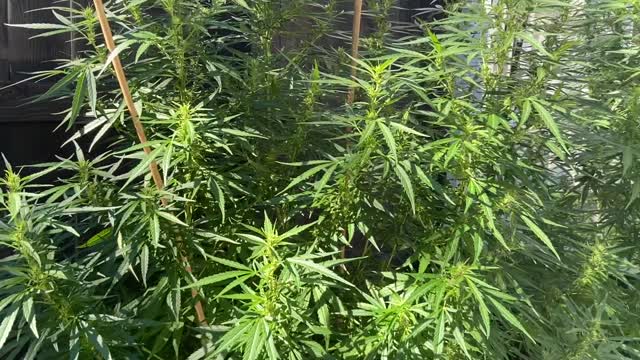Premium Only Content

8ft Tall Organic Cannabis Mother Plants Rain Damaged (Week 4 of Flowering)
Although broken, bent, and detached stems might seem like devastating problems, they can be easily fixed using simple methods. By using tape to re-attach or tighten stems, and by using support structures to upright bent stems, disaster can be swiftly evaded. Ignoring these problems, however, could lead to an unhealthy plant and a smaller yield.
The three most common types of stem damage are broken or split stems, bent or folded stems, and detached stems.
Broken Stems
When training rigid plants, or when training during the flowering phase, plants are at an added risk for broken stems. If left untreated, the branches of these stems will stop growing. These stems can be easily fixed with the tape method or with a support structure. Plants have a natural healing mechanism that will allow them to mend themselves. However, if you act quick enough, you may not even notice a reduction in the plant’s production on these branches.
Bent/folded Stems
This is the most common type of stem damage that occurs. When branches are bent or stressed too much by training techniques, permanent damage can occur. Bent or folded stems are unable to support themselves. Bends or folds can make it more difficult for branches to receive water and nutrients from the plant. These stems will continue to grow, but at a slower pace than the rest of the plant. This is not just because they are bent, but because their bending makes them hang lower, potentially blocking their exposure to light.
Detached Stems
Branches that have completely snapped off and detached themselves from the plant can be one of the most stressful problems to deal with. Luckily, these detached stems can be healed and mended with the same techniques used for other kinds of stem damage. They simply require more care and attention than bent or broken stems. However, if the detached stem is small, or located towards the bottom of the plant, it may be best to simply toss it away and cut your losses.
How Can You Fix Broken or Detached Stems?
The most common method of fixing broken stems is to use the tape method. Both duct tape and scotch tape can be used to help plants heal. Which kind you use will depend on the extent of the damage and the weight of the branch being mended.
Follow these steps to fix your broken stems:
Prepare a piece of tape about 10cm in length (you may need more for larger stems/branches).
Wrap the tape around the broken stem, making sure it fully covers its original base.
Ensure that the stem and its base are packed together tightly to allow mending.
Leave the tape on for between 2–4 weeks.
Check healing progress every day.
Tip: Instead of using tape alone, use a splint to offset the load from the injured branch. Tape a piece of wood or a pencil parallel to the break. Make sure you wrap the tape around the broken site with appropriate tightness. Wrapping it too loose will cause the broken ends to slip out of union. Wrapping it too tight will further damage the vegetative tissue. When it comes to removing the tape, do so with care to avoid further damage. If the tissue hasn't healed yet, you can easily create a tear if you’re too heavy-handed.
How To Fix Bent Stems
You can also use external supports to protect the injured site from the pull of gravity. After taping the break, follow the steps below to offload your broken branch.
Select a structure: There are plenty of structures to choose from, including a small plastic or metal trellis or simple bamboo stakes inserted into the soil.
Tie your plant: Use soft garden ties to gently bind the broken branch to the supporting structure. Apply one tie just before the break, and another one past the break to support the injury from both sides.
Add some stress: Remove the ties a few days before you plan to remove the tape. Giving your plant some time to adapt to the force of gravity will prepare the broken tissues for the initial shock.
It is generally inadvisable to rigidly secure cannabis in any way. Some flexibility allows the plant some natural motion. This will prevent, for example, stakes being pulled out or cages being blown away with your weed.
You have less control over the environment outdoors, but there are several things you can do to prevent wind burn:
(Greenhouses and polytunnels) If you have the luxury, these growing environments provide all the benefits of growing outdoors, just with extra protection.
(Find a sheltered spot) Start your grow in a sheltered area of your garden surrounded by hedges, trees, or taller plants. Just be mindful about light exposure; south-facing positions work best.
(Use trellises) Trellises and plant cages work to protect weed plants against strong winds. They won’t do much in the way of wind burn itself, but they’ll help to prevent broken stems.
(Top and trim plants) Keep your outdoor plants topped and trimmed to lower the canopy and create a more protective shape.
-
 LIVE
LIVE
TimcastIRL
42 minutes agoTrump Orders Review of Smithsonian For Being Woke & Out of Control | Timcast IRL
16,336 watching -
 LIVE
LIVE
MattMorseTV
1 hour ago🔴Tulsi just CLEANED HOUSE.🔴
2,576 watching -
 LIVE
LIVE
SpartakusLIVE
3 hours ago#1 ENTERTAINER of The EONS Eradicates BOREDOM
4,388 watching -
 LIVE
LIVE
Barry Cunningham
4 hours agoPRESIDENT TRUMP HAS TAKEN THE MONSTER AWAY FROM THE LEFT! HORROR STORIES WON'T WORK ANYMORE!
3,663 watching -
 1:07:59
1:07:59
BonginoReport
3 hours agoBoston Mayor Defies Trump, Protects Illegals - Nightly Scroll w/ Hayley Caronia (Ep.115)
62.5K44 -
 40:45
40:45
Donald Trump Jr.
4 hours agoPeace by Peace: Solving One Problem After Another | Triggered Ep.268
27.1K40 -

GritsGG
11 hours agoWin Streaking! Most Wins 3390+ 🧠
41.1K -
 1:08:29
1:08:29
TheCrucible
4 hours agoThe Extravaganza! Ep. 24 (8/19/25)
62.7K14 -
 4:22:25
4:22:25
sophiesnazz
5 hours agoLETS TALK ABOUT BO7 !socials !specs
3.18K -
 1:27:30
1:27:30
Redacted News
4 hours ago"There will be consequences!!!" Trump issues big threat to Putin ahead of peace summit | Redacted
86.8K147